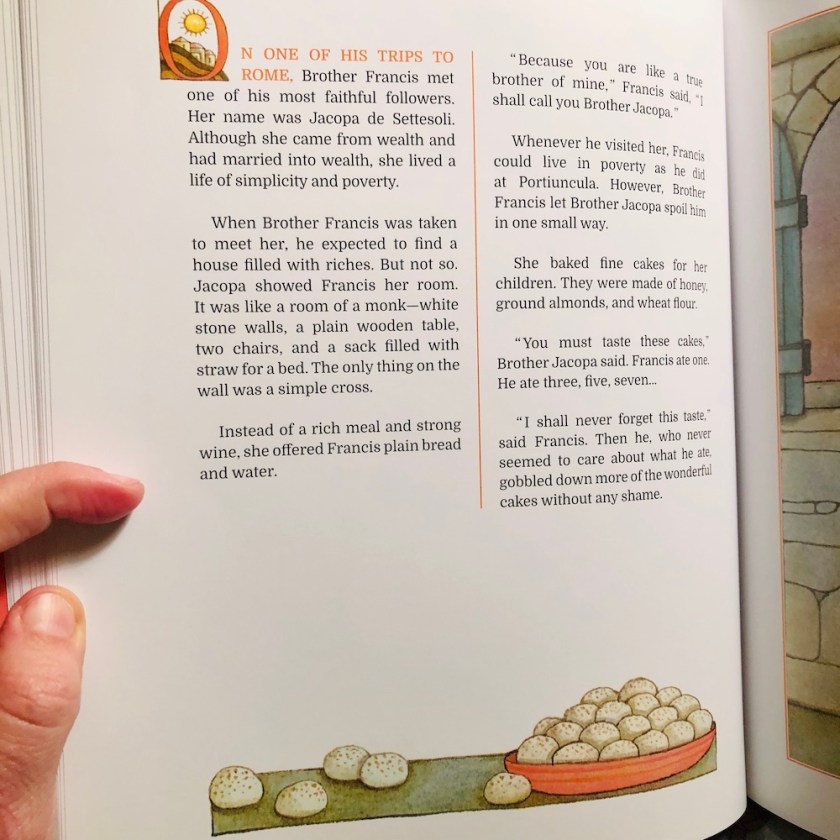A friend was very reasonably grousing about holy cards that make saints look like they’ve died halfway through a seizure. The mouths hang slightly open, the eyes are rolled up, and they’re pale as a corpse. That’s how sanctity is portrayed.
This gooey, sentimental style has just about died out, thankfully. I do understand why it was once popular, though. Artists were trying to depict someone who was in the world but not of the world. The rolled-up eyes and otherworldly stare were intended to show a holy detachment in a saint whose entire attention is fixed on Heaven.
Unfortunately, what it conveys to modern people is: “Saints are creepy weirdos who don’t care about you and are definitely not like you.” Pretty much the opposite of what we should be hearing, when we think of the universal call to grow in holiness and to be saints ourselves.
Another friend, an artist, commented,
“Honestly, though, anyone looking up to heaven looks pretty dumb. Just like anyone looking down at a baby looks pretty. Mary got lucky.”
It was just a quip, but she is onto something. There’s a reason we’re more drawn to this look:

than this one:

The otherworldly glow of her skin is warm, like embers, bidding you to draw closer, rather than pallid, like leprosy, repelling you; and her tender, gracious, intimate downward gaze at her beloved Child expresses the holiness the more sentimental artist was grasping at.
The thing is, in this picture, Mary is looking to Heaven. She is finding it in her son.
I once heard the account of the annunciation, and had a thought I’d never had before. The angel comes to Mary and says,
“Behold, you will conceive in your womb and bear a son, and you shall name him Jesus. He will be great and will be called Son of the Most High, and the Lord God will give him the throne of David his father, and he will rule over the house of Jacob forever, and of his kingdom there will be no end.”
But (as you know), “Mary said to the angel, “How can this be, since I have no relations with a man?”
Ha! I thought. The angel — an angel — just told her, “You are going to have a baby who will be THE SON OF GOD and He will BE KING OF EVERYTHING AND RULE FOR EVER. And her question is, “Okay, but about this pregnancy . . . ”
She’s not wondering about the theology of how a human child can be the son of God. She’s not thinking about salvation history or heavenly thrones or eternity — not right this moment. She just wants to know about her and the baby, and also about her husband-to-be. First things first. This is the conversation she wants to have with an archangel: Let’s talk about my son, that’s going to be in my body, because it’s personal.
That’s how Mary does things. There’s that downward gaze we associate with her. So much better than rolled-up eyes! It’s a good look, on Mary and on all of us: that personal, intimate, “You’re real and so am I” connection. Not a faraway gaze at something beyond the mysterious beyond, but at the Heaven that has located itself directly in our lives. And despite how artists often choose to portray it, I believe that, even during the Assumption, and most definitely afterwards, Mary did not forget her little ones, and however it happened that she was assumed into heaven, you would not catch her rolling her eyes away from us.
So this is how we can be like Mary, if you are looking for a way: Look to the ones who are closest to us. Look to their needs. Take their day-to-day existence seriously as our own concerns. That includes beloved family and friends, and the ones who are easy to smile at and cherish, but also the people whom God puts close to us whether we wanted to cross paths or not: the crabby customer service lady, the cantor whose warbling gets on your nerves, the snotty stranger who comments on your social media. And the family and friends who are behaving in ways that do not invite us to instinctively draw closer. If we can, it would be a good goal to remember Mary’s gaze — that intimate, personal, attentive focus — and try to adopt that. Because that’s what holiness looks like.
Sometimes, let’s be real, the best we can do is recruit Mary to our side, and ask her to be the one to be loving and attentive, when we can’t or shouldn’t get too close to someone ourselves. This is holy, too, and this is a way to sanctify our relationships with other people. Mary will be there. She will do that for us. She will be the person who will make it personal.
But holiness has to be personal. If it’s impersonal and abstract, if it remains closed off from other people, then it’s not holiness. Like it or not, sanctifying our responses to each other is how we will find Heaven. Don’t roll your eyes at me! Not in exasperation, and not in sentimental piety, either. This is how we find Heaven. It’s personal.
***
A version of this essay was originally published in The Catholic Weekly in December of 2017.
Images:
Photo of St. Gerard statue holy card courtesy of a friend
Adoration of the Shepherds (detail) by Gerard van Honthorst [Public domain], via Wikimedia Commons]
























































